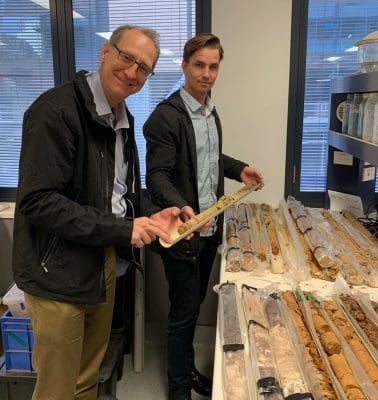GRAIN growers may soon be able to map soil in their paddocks without sending a single sample to the laboratory thanks to the efforts of an innovative young researcher.
University of Sydney postdoctoral research fellow, Edward Jones, is working on new technology with Grains Research and Development Corporation (GRDC) investment, examining how sensors can be used to scan soil for properties such as clay content, water holding capacity, sodicity and pH.

GRDC agronomy soils and farming systems – south Stephen Loss with University of Sydney digital soil scientist Edward Jones, who has been working with a range of sensors – including a near-infrared spectrometer – to scan soil samples and develop a map identifying soil variations across a paddock. (Photo: GRDC)
His work has shown that by using a range of sensors to scan multiple soil samples across a paddock, it is possible to build an accurate digital soil map identifying variation within a paddock.
GRDC manager agronomy, soils and farming systems – north, John Rochecouste, said the ability to map soil types in paddocks, without sending samples to the laboratory, would be an invaluable management tool for grain growers and potentially save them significant costs.
“Soil properties do not change rapidly, so once growers have developed a digital map it would become an important tool to guide their decision making and importantly it would not need to be updated annually,” Dr Rochecouste said.
“Soil properties don’t change significantly for pretty much decades, if not longer, unless there has been major intervention such as incorporating significant amounts of lime or gypsum.
“Things like sodicity and clay content are pretty fixed without intervention. While pH can decrease (acidify) gradually with time, but essentially they are pretty much fixed properties.
“Nutritional element can vary significantly over seasons so that’s why nutritional sampling is treated differently. To 3D characterise a paddock is very expensive in terms of sampling costs, so this work by Dr Jones is looking at significantly reducing this expense.
“Knowing your soil characteristics across a paddock, and the variation within paddocks, is invaluable information and really is the foundation for effective crop planning and management.”
However, there is a series of complex steps required to develop sensors which can effectively calculate soil properties.
“To be able to predict properties of a new soil sample you must first build a soil spectral library. Fortunately, the University of Sydney has been stockpiling soil samples from research projects dating back decades,” Dr Jones said.
“So far in the project we have delved deep into this stockpile and scanned more than 8000 samples, primarily from the wheat-sheep belt of eastern Australia.”
The digital soil scientist said when samples were scanned with one of the sensors, they produced a unique response, like a spectral fingerprint. From here he has been able to build models using the samples in the spectral library to estimate the properties of new samples that were scanned.
“The most exciting thing has been the speed at which this technology is developing. One of the sensors I am using is a visible near-infrared spectrometer – the same technology used to estimate grain protein and moisture content at receival depots,” Dr Jones said.
“When I started my PhD in 2014 one sensor was the size of a briefcase and cost around US$60,000. A sensor that I am currently testing is the size of a deck of cards and costs only US$3000.”
He said the next generation sensor was the size of a postage stamp and could be incorporated into a phone case and run using a smart phone. The same sensor could also be used to scan plant leaves to diagnose a range of nutrient deficiencies.
“I am very excited for the day that this technology is widely available to growers and advisers, because getting as much information that you can about your soil is crucial to good crop management,” Dr Jones said.
“Understandably the sensor does have its limitations. Everybody wants to be able to predict plant available nitrogen, but the technology is not advanced enough at this stage.
“Some private companies are saying that they can predict all of a crop’s nutritional requirements from a single scan and this is simply not true.”
Dr Jones advised growers to exercise caution with any organisations claiming fertiliser recommendations could be made using sensor technology.
“At the moment, the sensor technology is not advanced enough to assess fertility management, so for that sort of information growers need to keep sending samples to the laboratory for accurate assessment.”
Dr Jones has been trialling the new sensors and digital soil mapping techniques at the University of Sydney’s northern New South Wales L’lara research property at Narrabri.
His plan is to showcase these digital technologies destined for broadacre agriculture to growers, farm advisers and industry stakeholders at a field day in early 2020.
Source: GRDC
More information: https://bit.ly/2Y7QePp

HAVE YOUR SAY